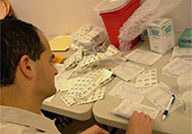Success Stories: CDC Tracks the Panama "Mystery Illness"

Tainted cough medicine contained DEG poison.
What if your child suddenly turned deathly ill and you had no idea why? What if you learned eventually that the child had swallowed poison from cough medicine? That was the nightmare that parents in the Republic of Panama experienced.
Beginning in late September of 2006, media headlines spoke of a “mystery illness” responsible for numerous deaths and almost two-dozen seriously ill patients in the Republic of Panama. As Panama’s Minister of Health worked to keep people informed and calm, he and his colleagues requested assistance from the CDC, Pan American Health Organization (PAHO), and U.S. Food and Drug Administration in tracking the unknown killer. CDC toxicology experts from the Health Studies Branch (HSB) helped unravel this deadly and unanticipated threat.
Closing in on a Killer
By September 20, doctors working in the Social Security hospital had recognized a pattern of cases and began to track, diagnose, and report them. Then, on September 28, the Social Security health care system reported the suspicious pattern to the Ministry of Health, which began coordinating a national response and requested international assistance.
The illness—which started with diarrhea and fever and progressed to acute kidney failure, paralysis, and death—seemed to be striking mostly men over 60 whose only significant common denominators were standard treatments for high blood pressure, diabetes, or kidney disorders.
When Jorge Motta, MD, director of GMIHR, first contacted CDC in October, the origin of the outbreak was unknown. CDC assembled a team, pulling expertise from across the agency: National Center for Environmental Health (NCEH); HSB; National Center for Zoonotic, National Center for Zoonotic, Vector-born, and Enteric Diseases; and the Regional Office in Guatemala. The CDC team quickly gathered medical samples from patients—as well as a variety of suspected sources for the possible poisoning—and sending them back to the agency’s infectious-disease and environmental laboratories in Atlanta.
Early evidence such as no clustering of illness within families and no healthcare providers getting sick suggested the event was not contagious. Nonetheless, CDC’s team and laboratories tested specimens of kidney and nerve tissue for infectious diseases while simultaneously conducting urgent laboratory examinations of products such as high blood pressure medication and simple cough syrup found in patients’ homes. Just nine days after the CDC team landed in Panama, DEG was isolated as the culprit.
Panamanian Health Officials Pull Medication
Somehow, diethylene glycol (DEG) was introduced into government-made, generic-label, sugar-free cough and anti-allergy syrups. DEG is a water-soluble, clear liquid commonly found in brake fluids, antifreeze, and fuel additives. It is also used to retain moisture in the industrial processing of tobacco products; in the treatment of corks, glue, paper and cellophane; and in the manufacture of unsaturated polyester resins, polyurethanes and plasticizers. Exposure to large amounts of DEG can damage the kidneys, heart, and nervous system.
Panamanian health authorities quickly withdrew the contaminated medications as well as those potentially contaminated by DEG, and people were notified to immediately discontinue their use. The medications were all compounded in a production laboratory operated by the Panamanian Social Security hospital system. Government officials are investigating how contaminated ingredients came to be included in these common medications.
Detective Work, Cooperation Solve the Riddle
“From the start, this has taken a lot of effort from a lot of people,” says Carol Rubin, DVM, MPH, then HSB chief. “This amazing collaboration identified the probable cause of this syndrome within a remarkable 11 days of the initiation of the investigation by the Ministry of Health.”
Solid, old-fashioned epidemiological detective work and round-the-clock evidence gathering on the ground in Panama found the answer. Among the many anecdotal leads being pursued and household items being sent off to Atlanta and FDA labs, an epidemiologist from the Health Ministry first noted that cough syrup was another common factor among patients affected by what news reports were calling a “mystery illness.”
“This incident amplifies the importance of international cooperation,” says CDC’s Jana Telfer, Associate Director for Communication (NCEH), who was on the ground in Panama to assist officials there with communications efforts. “The Ministry has done all the right things in this truly multi-national, multi-jurisdictional effort—first and foremost by requesting assistance from the international community.”
- Page last reviewed: August 12, 2013
- Page last updated: August 12, 2013
- Content source:


 ShareCompartir
ShareCompartir